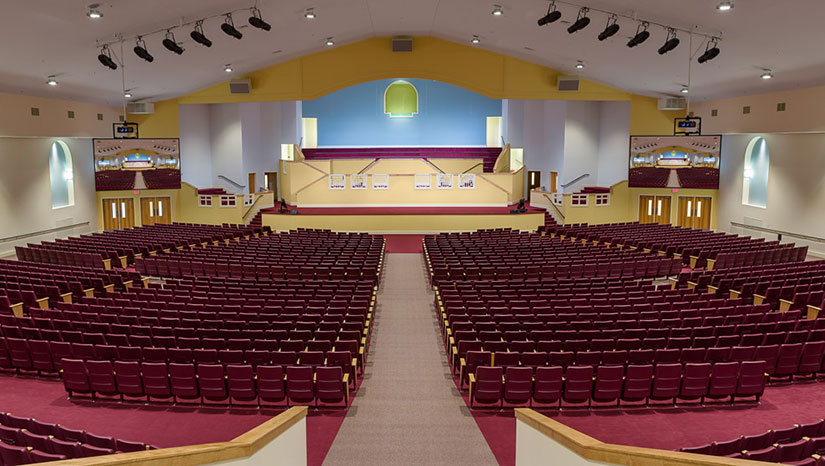It’s usually obvious when a new church facility is needed, and it typically comes in the form of “growing pains.”
Maybe your established congregation has outgrown its worship space, and it makes sense to erect a new sanctuary adjacent to the existing one. Perhaps your church is young and has reached a point where you’re ready to acquire land and build from the ground up. Or it could be that your church is expanding its ministries and needs a school or day care facility, fellowship space, or recreational facilities.
Regardless of the needs of your church, planning for expansion and building comes with a long list of factors to consider before you can even think about building design and construction. Different from most other commercial construction projects, churches are a part of the community and can be high profile in nature. The need for a well-thought-out plan of action is paramount so that communication to the congregation, as well as the local community, is thorough and well managed.
Bobbitt has worked in this capacity with dozens of religious institutions over the past 20 years. We recommend the following steps to ensure the process unfolds smoothly and buy-in is collected from congregants, local leaders and the community at large.
Step 1: Financing the church construction project
First and foremost, you must have the ability to fund the project. In addition to traditional bank loans or bonds, churches often fund new facilities through a focused capital campaign. While many church congregants make weekly offerings to the Sunday collection, some members are happy to provide additional support through a monthly or annual pledge if they understand this will benefit a long-term building project. Larger contributions can come from major donors, and others may even consider the church in their estate planning.
If your church’s expansion relies on fundraising, be sure to demonstrate clearly how future plans will enable the church to pursue its mission and support important programs and ministries.
Once you know your budgetary parameters or at a minimum have an estimate of the financial range you can afford, it is then time to select a design-build company to manage the entirety of the design and building process for you and your team.
Step 2: Look for experience
By now, you’ve likely established a church building committee, but chances are those individuals do not have extensive experience in building architecture and construction. Hiring a design-build company will enable your committee to have an expert on the team to advise you at critical decision points throughout the process. This resource can lead you on the path to a successful construction project.
It makes sense to seek out a company with a history of designing and constructing churches and religious facilities. Only consider companies with a strong portfolio of related projects to guarantee you are getting an expert that understands all the nuances of this specialty process.
Step 3: Establishing project goals
Your design-builder will help you and your team take an in-depth look into your church needs. This includes how your personnel and members utilize your current space and what may be lacking that could help both the church and the surrounding community. With an understanding of your current environment, you are now ready to identify needs and goals for the new facility. One great way to determine your needs is to poll church members on what they would like to see in a new building.
Now you are armed with information about your current operations, future needs, and a “member wish list.” Your design-builder can develop a space program and begin preliminary designs for your project. Then they will produce a floor plan along with elevations and renderings. Upon completion of this stage, you may choose to hold a church-wide meeting to answer comments and questions. Providing stakeholders an opportunity to speak their minds helps create buy-in from all parties.
Step 4: Choose the appropriate site
You now have a plan, including the size of the new structure. It is now time to evaluate your building site or select a site if you do not already have one. Site selection is a key factor in the success of every church project. Factors include proximity to members, road accessibility, adequate parking, property drainage, landscaping, etc.
You will want to include your design-builder in the property search so they can advise you of constructability advantages and disadvantages of each property being considered. They will help you evaluate essential site selection criteria such as location, property contours and elevations, soils type, available utilities and expandability.
Once you have a site selected, it is wise to perform a survey and geotechnical investigation on the property during your due diligence period. This will verify that there are no underlying issues that cannot be seen by the naked eye. Your design-builder can help with this step, as well.
Positioned for success
By carefully following these planning steps and selecting an experienced, qualified design-build partner, you will have laid the groundwork for a successful outcome. You now have funding sources identified, a pre-construction plan in place, and the building site selected. Your design-build team will lead you through a seamless transition from project planning to the church design, construction and permitting phases.
Learn more about design-build and Bobbitt’s partnership with Butler Manufacturing. Then give us a call to discuss your church building project!
919-851-1980
803-731-5550
View our church building portfolio!

